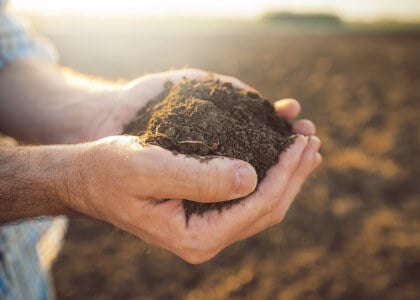Learning About Soil Types
The size and proportion of clay, sand or silt particles present in your garden soil influence its chemical and physical nature. They make it either heavy (wet and poorly drained), or light (dry and free-draining), and thus determine what plants will thrive on it. Its pH value, a measure of acidity or alkalinity is measured on a scale of 1 to 14. Below neutral (7), soils are progressively acid; above neutral, they are progressively alkaline (limy). You can determine what type of soil you have by looking at the color, feeling the texture, and observing what kind of plants will grow on it or, if you prefer, by doing a soil test. You can always contact your local UW-extension to have them help you get your soil tested.
Silty Soils

The ideal plants for silty soils are Willow, Birch, and Chokeberry
Silty soil is considered one of the gold standards in soils. This is a very fertile soil that has an irregular shape and the small size of its soil particles allows for good aeration. At the same time, it can hold on to water like clay soil but drains better than sandy soil. It can also store plant nutrients better than clay because of its compact-able nature. Silty soil is often native to river valleys. Because silt is almost as fine as clay, its soil particles could get densely and tightly packed if mishandled. Minimize walking on garden beds to prevent compacting the soil. Make sure you turn over several inches of the top layer of the soil every so often to keep the soil crumbly and easily manipulated.
Heavy Clay Soils

Heavy clay soils are ideal for Barberry (Berberis), Black-Eyed Susans, Geranium plants.
Minute clay particles stick together, making clay soils slow-draining after rain, sticky, and likely to bake hard in the hot sun. They are often highly fertile, they can be improved by draining or by adding grit or coarse organic matter. But the clay's density allows the soil to retain and hold large amounts of water and nutrients, while at the same time making it hard for moisture and air to penetrate it.
Sandy (Light) Soils
Sandy soils are ideal for plants like Goldfinger Potentilla, Gold Drop Potentilla, Aster, and Coneflower
Sandy particles are much larger than clay particles, making sandy soils light, free-draining, and quick to warm up in spring. Some plants may need frequent irrigation and feeding, though fertility can be improved by adding organic matter. These soils drain quickly after rain or watering, are easy to cultivate and work. On the other hand, they dry out quickly and are low in plant nutrients, which are quickly washed out by rain. Sandy soils are often very acidic.
Acid (Peaty) Soils

Acid or Peaty soils are ideal for Rhododendron plants, Fothergilla, Iris, Magnolia, Hydrangea, Dogwood, and Beech
This soil is generally dark (brown or black), and rich in organic matter. The acid in nature and moisture-retentive, they are favored by plants not tolerant of alkaline soil and can be made more free-draining by adding coarse sand. Acid or peaty soils help keep plants healthy even in dry weather because of their high water and nutrient contents and protect the plants from harm in rainy months. This soil is good for controlling plant diseases and can be used to balance the pH level of other kinds of soils.
Loamy Soils

The ideal plants for Loamy soils are Ferns, Coreopsis, Switchgrass, Viburnum, and Daylily
Loamy soils are considered by most gardened to be the ideal soil. It has a mixture of clay, sand, silt, and even some humus that makes this soil avoid the extremes of clay or sandy soils. This soil drains well, can be easily worked, and is definitely fertile. Although there can be clay-loam or sandy-loam depending on their predominant composition and cultivation. The pH level of loamy soil is 6 with high calcium levels and can retain nutrients and water. Add a bit of compost or any organic matter, especially if you're digging or cultivating this soil every year.
Alkaline (Limy/Chalky) Soils

Some ideal plants for Alkaline (limy/chalky) soils are Bur Oak, Honeylocust, Lilac, Juniper, & Hosta
Limy or Alkaline soils are usually shallow and/or stony. Free-draining, they warm up quickly in spring and are moderately fertile. Like sandy soils, they benefit from the addition of organic matter. Many chalky soils are shallow, free-draining, and low in fertility, but variations exist, and where there is clay present, nutrient levels may be higher and the water holding capacity greater.
*Keep in mind that this is just a guide and photos may not necessarily depict the exact soil. You should always test your soil and not base it off of these photos or information alone.
What have you learned about soils gardening over the years? Was there something you learned in our post that you never knew before? What are some of your tricks and tips with soils? We would love to hear from you below!


